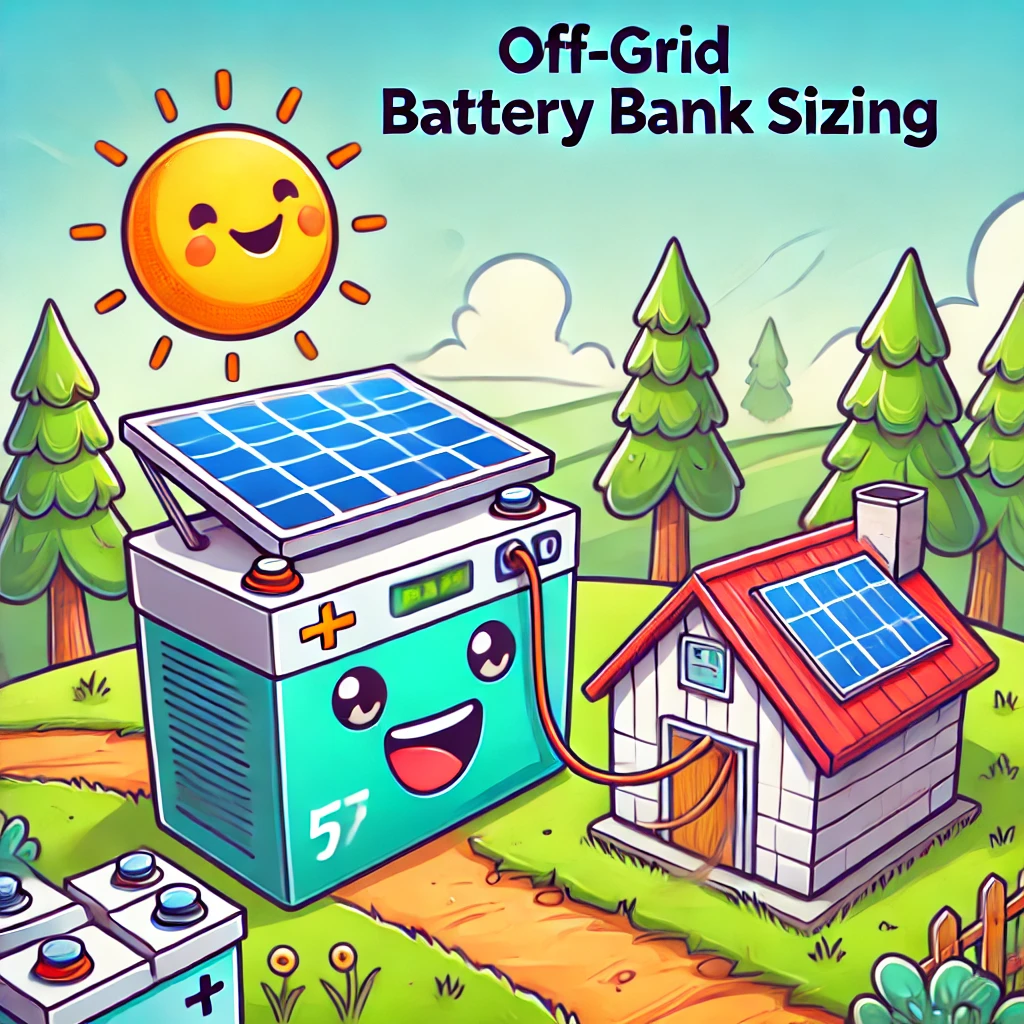As more individuals seek energy independence, off-grid battery banks have become a crucial part of sustainable power solutions. Whether you’re powering a remote cabin, an RV, or an entire household, accurately sizing your battery bank is key to ensuring reliable energy storage. This guide explores the essential steps to help you determine the right battery bank size for your specific needs.
Importance of Proper Battery Bank Sizing
When setting up an off-grid solar system or a backup power solution, choosing the right battery bank size is crucial. A properly sized battery bank ensures that you have enough stored energy to meet your needs without overspending on unnecessary capacity. Here’s why proper battery bank sizing is so important:
1. Dependability
A well-sized battery bank guarantees a consistent and reliable power supply, even during periods when solar energy generation is low—such as cloudy days or at night. If your battery bank is too small, you risk running out of power when you need it most. On the other hand, a properly sized system ensures you can keep your essential devices running smoothly without interruptions.
2. Extended Battery Life
Batteries have a limited number of charge and discharge cycles. When a battery is consistently over-discharged or drained too deeply, it can significantly shorten its lifespan. Properly sizing your battery bank prevents these deep discharges, keeping the battery within its optimal charge range. This not only extends the life of your batteries but also saves you money in the long run by reducing the frequency of replacements.
3. Cost Efficiency
Oversizing your battery bank might seem like a safe bet, but it can be unnecessarily expensive. Batteries are one of the most costly components of a solar energy system. By accurately calculating your energy needs, you can avoid overspending on excess storage capacity that you may never fully use. This ensures you get the best return on investment without sacrificing reliability.
4. Optimal Performance
A battery bank that is too large or too small can negatively impact the performance of your entire solar power system. An undersized battery bank may not store enough energy for your daily needs, while an oversized one may not charge efficiently, leading to wasted solar power. Proper battery bank sizing helps balance energy storage with your daily power consumption, ensuring your system operates at peak efficiency and provides consistent performance.
In short, getting the size right means a more reliable, cost-effective, and efficient solar energy system that meets your energy needs while protecting your investment over time.
Why Proper Off-Grid Battery Bank Sizing Matters
When designing a solar energy system, one of the most critical decisions you’ll make is determining the correct size for your battery bank. Getting this right ensures your system runs efficiently, reliably, and cost-effectively. An improperly sized battery bank can lead to a host of issues, from inconsistent power supply to unnecessary expenses. Here’s why choosing the right battery bank size is essential:
1. Reliable Power Supply
A correctly sized battery bank ensures you have a steady and dependable power source, even during periods when your solar panels aren’t generating enough electricity—like during cloudy weather or at night. If your battery storage is too small, you risk running out of power when you need it most. On the flip side, a well-sized battery bank provides peace of mind, knowing your essential devices will stay powered at all times.
2. Longer Battery Lifespan
Batteries degrade over time, especially when they are frequently over-discharged. Deep discharges can significantly reduce a battery’s lifespan, leading to early replacements. By sizing your battery bank correctly, you prevent excessive draining, keeping the batteries within their optimal charge range. This helps maximize the longevity of your batteries and reduces long-term maintenance costs.
3. Cost-Effective Investment
While it might seem like a good idea to buy extra battery capacity “just in case,” this can lead to overspending. Batteries are among the most expensive components in a solar system. Overestimating your storage needs means paying for capacity that you might never fully utilize. A properly sized battery bank ensures you’re investing in exactly what you need—nothing more, nothing less—keeping your budget in check without compromising on performance.
4. Maximized System Efficiency
An oversized or undersized battery bank can throw off the balance of your solar system. A battery bank that’s too small may not hold enough energy to meet your daily usage, leading to frequent power shortages. Conversely, a battery bank that’s too large may not charge efficiently, wasting the solar energy your panels produce. The right battery size optimizes your system’s performance, ensuring energy is stored and used efficiently to meet your daily power demands.
In summary, proper battery bank sizing is the key to creating a solar energy system that delivers reliable power, protects your battery life, saves money, and operates at peak efficiency. It’s a smart move that pays off in performance and long-term savings.
Steps to Determine the Right Off-Grid Battery Bank Size
1. Assess Your Daily Energy Needs
To determine the right battery bank size, start by calculating your daily power consumption:
- List all devices and appliances that require power.
- Identify their wattage ratings.
- Estimate their daily usage in hours.
- Multiply watts by hours to get watt-hours (Wh) per device.
Example Calculation:
| Appliance | Power (W) | Hours Used/Day | Daily Consumption (Wh) |
|---|---|---|---|
| LED Lights | 10 | 5 | 50 |
| Laptop | 60 | 4 | 240 |
| Refrigerator | 150 | 10 | 1500 |
| Total | – | – | 1790 Wh/day |
2. Convert Watt-Hours to Amp-Hours (Ah)
Batteries are rated in amp-hours (Ah), requiring conversion from watt-hours:
Formula:
For a 24V system:
3. Factor in Depth of Discharge (DoD)
Batteries shouldn’t be fully depleted. Standard discharge limits include:
- Lead-acid batteries: 50% DoD
- Lithium-ion batteries: 80% DoD
Using 50% DoD for lead-acid batteries:
4. Account for Days of Autonomy
Backup storage for cloudy days is essential. If you want 2 days of backup, multiply:
5. Adjust for Battery Efficiency
Since battery storage isn’t 100% efficient, account for energy losses. If efficiency is 90%, adjust as follows:
6. Choose the Right Battery Type
- Lead-Acid Batteries: Cost-effective but heavier and lower efficiency.
- Lithium-Ion Batteries: Higher efficiency, longer lifespan, but more expensive.
- Saltwater Batteries: Environmentally friendly but less common.
Example Battery Bank Selection
For 331.46 Ah at 24V, suitable options include:
- Six 100Ah 12V lithium batteries (series-parallel configuration)
- Four 200Ah 12V lead-acid batteries (series connection)
Final Thoughts
Correctly sizing your off-grid battery bank is vital for uninterrupted power. By calculating daily energy needs, considering discharge depth, and factoring in days of autonomy, you can select an efficient and cost-effective energy storage solution. Whether for a home, RV, or cabin, a well-sized battery bank ensures energy security and long-term savings.




